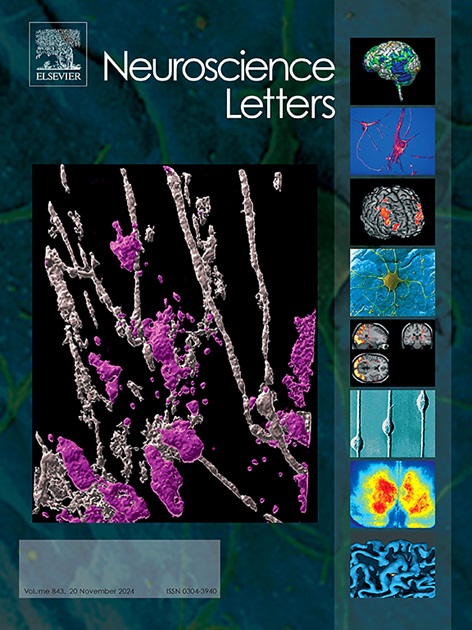(−)-Epigallocatechin-3-gallate (EGCG) decreases neuronal network excitability and interictal like activity in mouse brain slices
IF 2.5
4区 医学
Q3 NEUROSCIENCES
引用次数: 0
Abstract
(−)-Epigallocatechin-3-gallate (EGCG), the main flavonoid in green tea, is best known for its antioxidant and anti-inflammatory effects. EGCG interacts with certain ion channels and modulates ionic currents. However, its acute effect on neuronal activity is not known. In the present study, the effects of acute EGCG application on the excitability of neuronal network and epileptiform discharges were investigated. Acute brain slices were used for electrophysiological recordings. 370 µm thick entorhinal-hippocampal horizontal slices were obtained from 7-8 weeks old C57BL/6 mice. 100 µM 4-Aminopyridine (4AP) was used to induce epileptiform activity. Extracellular recordings of epileptiform activities were evaluated in the entorhinal cortex and hippocampus CA1 region. Additionally, the affinity of EGCG on the GABA-A receptor was evaluated in the central nervous system using the molecular docking method. Bath application of 10 μM and 50 μM EGCG reduced interictal event frequency in both entorhinal cortex and hippocampus. EGCG at 50 μM suppressed the absolute power of neuronal oscillations. To be able to explain these effects, we have analysed docking properties of EGCG to GABA-A receptor. The binding energy between EGCG and the GABA-A receptor was calculated as −7.41 kcal/mol. The affinity of EGCG for the GABA-A receptor is satisfactory compared to the reference molecule Diazepam. Findings showed for the first time that the acute application of EGCG had an inhibitory effect on neuronal excitability and also on synchronized events. EGCG might have a potential as a novel anti-seizure molecule.
(−)-表没食子儿茶素-3-没食子酸酯(EGCG)降低小鼠脑切片中神经元网络的兴奋性和间期样活动
(−)-表没食子儿茶素-3-没食子酸酯(EGCG)是绿茶中的主要类黄酮,以其抗氧化和抗炎作用而闻名。EGCG与某些离子通道相互作用并调节离子电流。然而,其对神经元活动的急性影响尚不清楚。本研究探讨了急性应用EGCG对神经网络兴奋性和癫痫样放电的影响。急性脑切片用于电生理记录。7-8周龄C57BL/6小鼠获得370µm厚的内嗅-海马水平切片。用100µM 4-氨基吡啶(4AP)诱导癫痫样活性。在内嗅皮质和海马CA1区评估癫痫样活动的细胞外记录。此外,利用分子对接法评估EGCG对GABA-A受体在中枢神经系统中的亲和力。10 μM和50 μM EGCG均可降低内嗅皮质和海马的间期事件频率。50 μM的EGCG抑制神经元振荡的绝对功率。为了能够解释这些影响,我们分析了EGCG与GABA-A受体的对接特性。EGCG与GABA-A受体的结合能为- 7.41 kcal/mol。与参比分子地西泮相比,EGCG对GABA-A受体的亲和力令人满意。研究结果首次表明,急性应用EGCG对神经元兴奋性和同步事件有抑制作用。EGCG可能有潜力成为一种新的抗癫痫分子。
本文章由计算机程序翻译,如有差异,请以英文原文为准。
求助全文
约1分钟内获得全文
求助全文
来源期刊

Neuroscience Letters
医学-神经科学
CiteScore
5.20
自引率
0.00%
发文量
408
审稿时长
50 days
期刊介绍:
Neuroscience Letters is devoted to the rapid publication of short, high-quality papers of interest to the broad community of neuroscientists. Only papers which will make a significant addition to the literature in the field will be published. Papers in all areas of neuroscience - molecular, cellular, developmental, systems, behavioral and cognitive, as well as computational - will be considered for publication. Submission of laboratory investigations that shed light on disease mechanisms is encouraged. Special Issues, edited by Guest Editors to cover new and rapidly-moving areas, will include invited mini-reviews. Occasional mini-reviews in especially timely areas will be considered for publication, without invitation, outside of Special Issues; these un-solicited mini-reviews can be submitted without invitation but must be of very high quality. Clinical studies will also be published if they provide new information about organization or actions of the nervous system, or provide new insights into the neurobiology of disease. NSL does not publish case reports.
 求助内容:
求助内容: 应助结果提醒方式:
应助结果提醒方式:


